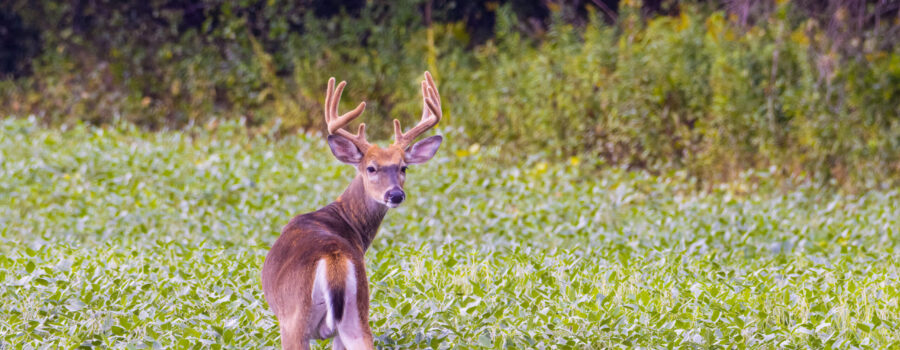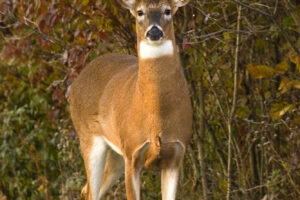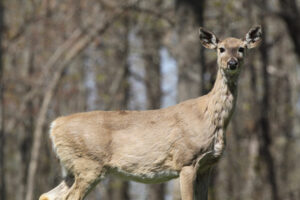Whitetail deer are a common sight in many areas of the country and are a favorite among hunters and wildlife enthusiasts. One way to attract and nourish these beautiful creatures is by planting a food plot on your property. But with so many food plot seed options available, which one is the best for whitetails? Let’s explore the top options.
- Clover: Clover is a top food plot choice for whitetails due to its high protein content and high palatability. It’s easy to grow and can provide a food source for deer for several months.
- Rape: Rape is another excellent choice for whitetails, as it grows quickly and provides a high-quality food source. Rape is also a great option for late-season food plots, as it can continue to grow even when temperatures drop.
- Soybeans: Soybeans are another popular food plot choice for whitetails, as they contain high levels of protein and are easily digestible. They also grow well in a variety of soil types, making them a versatile option.
- Brassica: Brassica is a type of turnip that provides a high-quality food source for whitetails. It’s a great option for early-season food plots, as it can be planted and grown quickly.
- Corn: Corn is a classic food plot option for whitetails, as it’s high in carbohydrates and provides a source of food throughout the season. However, it’s important to keep in mind that corn can also attract other wildlife, such as bears and raccoons.

Food plots not only provide a food source for whitetails, but they also offer numerous benefits to the local ecosystem. By planting a diverse mix of crops, you can create a habitat that provides a variety of food sources and shelter for many different species of wildlife. Additionally, food plots can also help to improve soil health, reduce soil erosion, and provide a source of fresh water for animals. Planting food plots can also increase the overall health and population of whitetail deer, making them easier to spot and observe. This can be especially beneficial for hunters, who can use the food plots as hunting locations. Food plots can also provide an opportunity for outdoor recreation, such as hiking, bird watching, and wildlife photography. Overall, planting food plots for whitetails is a great way to support and enhance the local ecosystem.
Clover: A Nutritious and Popular Food Source for Whitetail Deer
Clover is a popular and highly nutritious food source for whitetail deer. It’s known for its high protein content, which is essential for the growth and health of deer. Additionally, clover is very palatable to whitetail deer, making it a great option for food plots.
One of the biggest benefits of clover is its long-lasting food source. Unlike other food plot options that only provide food for a short period of time, clover can continue to provide a food source for several months. This makes it a great option for those who want to attract and nourish whitetail deer on their property for an extended period of time.
Clover is also very easy to grow and does not require a lot of maintenance. It can be planted in a variety of soil types and climates, making it a versatile option for those looking to attract and nourish whitetail deer.
In conclusion, clover is a popular and nutritious food source for whitetail deer. It provides a long-lasting food source, is easy to grow, and is highly palatable to whitetail deer. If you’re looking to attract and nourish whitetail deer on your property, consider planting clover in your food plot.



Rape: A Guide to a Successful Rape Food Plot
Rape food plots can be a valuable source of food for whitetail deer, providing them with high-quality nutrition throughout the year. Rape is a fast-growing, cool-season annual plant that produces high yields of leaves and stems that are high in protein and digestible carbohydrates. To create a successful rape food plot for whitetails, it is important to consider the following factors:
- Soil preparation: Choose a well-drained site with fertile soil and a pH between 6.0 and 7.0. Till the soil to a depth of 6-8 inches and add compost or fertilizer if necessary to improve soil fertility.
- Seed selection: Choose a high-quality rape seed that is specifically designed for food plots. Avoid seed mixes that contain other crop species, as they may compete with the rape for nutrients and water.
- Planting time: Plant rape in the spring or fall, when temperatures are cool and soil moisture is abundant. Plant seed at a depth of 1/2 to 1 inch and follow the recommended seeding rate for the variety you choose.
- Maintenance: Keep the plot weed-free by mowing or herbicide application, and fertilize as needed to promote healthy growth. Irrigation may also be necessary during dry periods.
Soybeans: The Ultimate Whitetail Draw
Soybeans can be a valuable food source for whitetail deer, providing them with high-quality nutrition throughout the growing season. Soybeans are a warm-season annual plant that produce high yields of nutritious beans and leaves that are high in protein and digestible carbohydrates. To create a successful soybean food plot for whitetail deer, consider the following factors:
- Soil preparation: Choose a well-drained site with fertile soil and a pH between 6.0 and 7.0. Till the soil to a depth of 6-8 inches and add compost or fertilizer if necessary to improve soil fertility.
- Seed selection: Choose a high-quality soybean seed that is specifically designed for food plots. Avoid seed mixes that contain other crop species, as they may compete with the soybeans for nutrients and water.
- Planting time: Plant soybeans in the spring, after the last frost date in your area, when temperatures are warm and soil moisture is abundant. Plant seed at a depth of 1-2 inches and follow the recommended seeding rate for the variety you choose.
- Maintenance: Keep the plot weed-free by mowing or herbicide application, and fertilize as needed to promote healthy growth. Irrigation may also be necessary during dry periods.
Brassicas: A Nutritious Food Source for Whitetail Deer
Brassicas, a type of turnip, are a highly nutritious food source for whitetail deer. They are known for their high levels of protein, fiber, and minerals, which are essential for the health and growth of deer. Additionally, brassicas are highly palatable and attractive to whitetail deer, making them a great option for food plots.
One of the biggest benefits of brassicas is their ability to grow quickly and produce a high-quality food source in a short amount of time. They can be planted in early-season food plots and provide a food source for deer before other food plot options become available. This makes them a great option for hunters, who can use the food plots as hunting locations.
Brassicas are also very versatile and can be planted in a variety of soil types and climates. They are easy to grow and do not require a lot of maintenance, making them a low-effort option for those looking to attract and nourish whitetail deer on their property.
In conclusion, brassicas are a highly nutritious and attractive food source for whitetail deer. They are a great option for early-season food plots, are easy to grow, and provide a variety of essential nutrients for deer. If you’re looking to attract and nourish whitetail deer on your property, consider planting brassicas in your food plot.
Corn: Potentially the Main Food Source for Whitetails?
Corn is a staple food source for whitetail deer, providing them with important nutrients and energy during the colder months. In the wild, whitetails consume corn in the fields and along the edges of forests, where farmers may plant it as a cover crop or wildlife food plot. However, corn can also be provided to whitetails in the form of feeders, which can attract them to specific locations for observation or hunting.
The nutritional benefits of corn for whitetails include a high concentration of carbohydrates, which provide them with energy to survive harsh winter conditions. Corn is also rich in protein, which is essential for growth and the maintenance of healthy muscles and tissues. Additionally, corn contains minerals like phosphorus, which is important for bone health and antler growth in bucks.
When providing corn for whitetails, it is important to ensure that it is fresh and not moldy, as moldy corn can be toxic to deer and other wildlife. Corn should also be stored in a dry location to prevent spoilage. Additionally, providing corn in feeders can also help prevent waste, as it minimizes the amount of corn that is trampled or eaten by other animals.
In conclusion, corn is a valuable food source for whitetails, providing them with important nutrients and energy during the winter months. Whether it’s in the form of a natural food source or a supplementary feeder, corn can play an important role in the health and well-being of whitetail deer populations.
Conclusion
In conclusion, there are several excellent food plot seed options available for whitetails. Whether you choose clover, rape, soybeans, brassica, or corn, make sure to choose a seed that will provide a high-quality food source and grow well in your specific location. By planting a food plot, you can attract and nourish your local deer population, providing them with the sustenance they need to thrive.





Leave a Reply
Your email is safe with us.